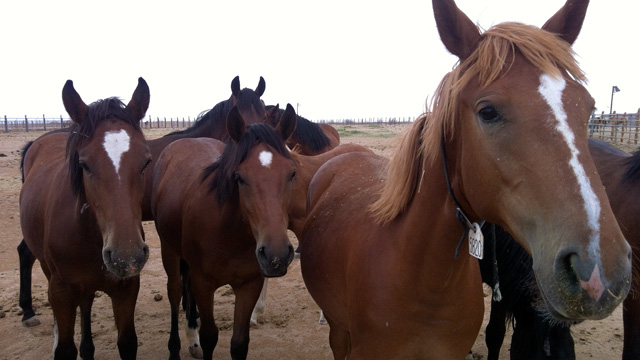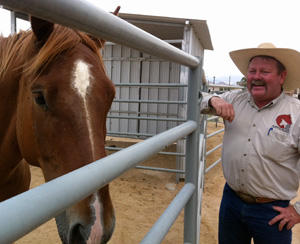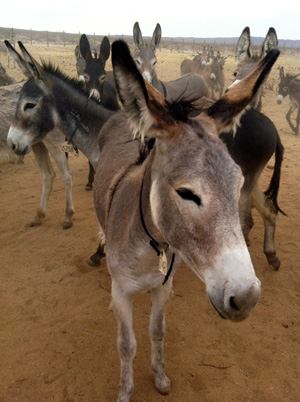Wild Horses Wait on New Pastures

Viewed in hindsight, it turns out the good intentions of horse advocates have led to bad consequences for horses. The slaughter prohibition discourages horse ownership. The wild horse population explosion has caused a backlash in sentiment towards wild horses. And, Mexican slaughter yards are less humane than America’s.
NOTE: This article originally appeared in:http://www.californiareport.org/ in October 2013
– Photo Credit (feature): http://stonerchic.files.wordpress.com/2011/11/horse-ii.jpg
Horse slaughter is a hot-button issue.
A federal court recently issued a temporary restraining order that blocked two horse slaughterhouses from opening, in response to a lawsuit against the U.S. Department of Agriculture brought by the Humane Society and other groups opposed to treating horses like commercial livestock. The district judge will decide the case at the end of October.
Meanwhile, wild horses and donkeys run free on public lands in California and across the West as “living symbols of the historic and pioneer spirit of the West.” They’re protected by the Wild Free-Roaming Horses and Burros Act of 1971.

Some activists say the Bureau of Land Management needs to better control this population, which is booming, instead of the usual round-up and adoption plan.
At the Ridgecrest corrals in rural Kern County, 750 formerly wild horses and burros hang out, eating hay on fenced-in patches of land. The corral is one of just two short-term holding facilities in California where the BLM takes animals rounded up in Nevada, Arizona and California.

Corral Manager Grant Lockie adopted a wild horse he calls Bubba. Lockie prefers wild horses to those bred in captivity. (Image credit: Caitlin Esch/KQED)
Corral Manager Grant Lockie adopted a wild horse he calls Bubba. Lockie prefers wild horses to those bred in captivity.
“These are just yearling fillies,” he said, opening the metal gate. The fillies retreat as we enter, eyeing us suspiciously. We ignore them, and slowly, the horses creep forward until they’re nosing my pockets, looking for a treat.
“They’re very curious, and that’s the thing. You see, her bubble just shrunk. She decided, ‘OK, I can see, she’s not bad,’” Lockie said.
The horses are – in theory – awaiting adoption. The BLM pulls the animals off public lands when their numbers get too high, vaccinates then, and adopts them out to private individuals for cheap.
Driving around Ridgecrest, BLM Branch Chief Robert Pawelek points to the China Lake Naval Station where nuisance donkeys sometimes wander on to the runway.
“Well, this is a naval air weapons station, and burros and F-18s don’t really mix. And sometimes we’re called to come gather them,” Pawelek said.
Pawelek says adoptions have dropped significantly in recent years, from about 8,000 to just 2,000 a year. So a lot of these animals end up staying in the short-term corrals for a while.
“Simple economics,” Pawelek said. “People will either feed their families or feed a horse. And a lot of ’em can’t feed both.”
As a result, the cost of keeping the animals is eating the majority of the BLM’s Wild Horse and Burro Program budget. Pawelek estimates he spends $1.5 million a year just to feed the Ridgecrest animals.
Out on the range, the horse population is doubling every four years.
“We’ve got these horses that we can’t do anything with,” Pawelek said. “We are, for what it’s worth, stuck with them. They’re stuck with us. And in the meantime, we’ve got the horses out on the range that need to find a good home too.”

Nuisance burros sometimes wander on to the runway at the nearby naval base. But wranglers say if you adopt one, they make great hiking companions. And they scare away coyotes too.
One obvious way – though controversial – to keep the numbers down is to kill them. While there are no horse slaughterhouses currently operating in the United States, a few are trying to open throughout the West amid intense local outcry. Animal rights activists say wild horses are still sold to foreign slaughterhouses, though the BLM denies the horses they pull off the range end up there.
Instead, un-adopted wild horses are sent to long-term pasture facilities and sanctuaries.
“We’re in a situation today,where there’s more horses off the range, being held in these pastures, than are actually on the range. It’s certainly not what the public expects from the wild horses program,” said Guy Palmer, director of the School of Global Animal Health at Washington State University.
Palmer also chairs the National Academy of Sciences committee that reviewed the BLM’s practices. The committee released a report earlier this summer saying, among other things, that the status quo is not sustainable. Palmer says the problem has been building for decades, and it’s finally reached a tipping point.
The report urges the BLM to manage the herds with fertility treatments.
“This is an independent, scientific review and they basically came out supporting everything that we’ve been saying for all these years,” said Deniz Bolbol of the American Wild Horse Preservation Campaign. She’s been fighting for years against controversial helicopter roundups and what she considers inhumane practices.
“We have video and pictures of helicopters hitting horses and burros with the skids, Bolbol said. “We have them running them in knee-deep snow, we have them running in hundred degree weather. So we need to have some checks and balances here on what’s happening.”
Bolbol and other activists want the BLM to use darts and other methods to administer birth control.
The BLM’s Robert Pawelek thinks more fertility control could work. But that won’t take care of all the horses and burros in the corrals. To try to boost adoptions, the BLM has partnered with organizations like the Mustang Heritage Foundation that host events like Extreme Mustang Makeover, where trainers spruce up a horse, and compete to get it adopted.
But until adoptions start picking up again, a lot of these horses will be hanging out in the short-term corrals for the foreseeable future.
Pawelek hopes folks considering buying horses will opt for a wild one instead of a horse bred in captivity.
“Maybe instead of buying a $3,000 quarter horse in Texas, maybe they’ll come out to Ridgecrest and adopt a really good mustang for $125.”
The BLM released a statement saying it would take the committee’s recommendations into account, but activists say the bureau is dragging its feet. Meanwhile, Pawelek says he’s not expecting any more roundups this fall, unless there’s an emergency on the range.
– See more at: http://www.californiareport.org/archive/R201309201630/e#sthash.HkMXZrQ0.dpuf
